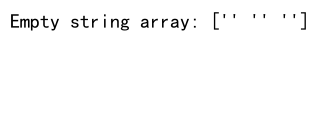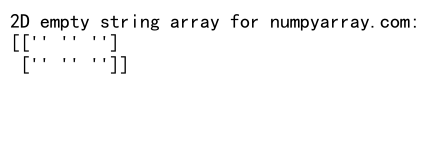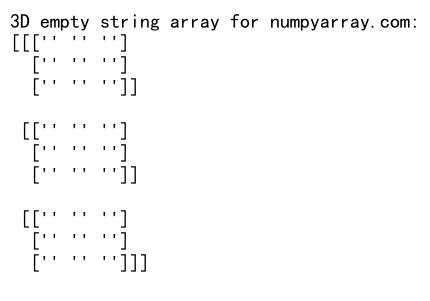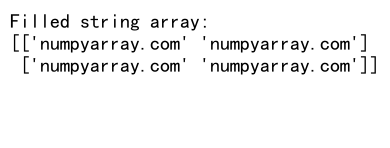NumPy创建空字符串数组的全面指南
参考:numpy empty array of strings
NumPy是Python中用于科学计算的核心库,它提供了高性能的多维数组对象和用于处理这些数组的工具。在处理文本数据时,创建空的字符串数组是一个常见的需求。本文将详细介绍如何使用NumPy创建空的字符串数组,以及相关的操作和注意事项。
1. 基本概念
在开始之前,我们需要了解一些基本概念:
- NumPy数组:NumPy的核心是ndarray对象,它是一个多维数组。
- 字符串数组:在NumPy中,字符串被视为一种特殊的数据类型。
- 空数组:指的是已分配内存但尚未填充具体值的数组。
让我们从最简单的例子开始:
import numpy as np
# 创建一个长度为3的空字符串数组
empty_str_array = np.empty(3, dtype='<U10')
print("Empty string array:", empty_str_array)
Output:

在这个例子中,我们创建了一个长度为3的空字符串数组。dtype='<U10'表示每个元素是一个最多包含10个字符的Unicode字符串。
2. 使用np.empty()创建空字符串数组
np.empty()函数是创建空数组的主要方法。它创建一个指定形状和类型的新数组,但数组的内容是随机的,取决于内存的状态。
import numpy as np
# 创建一个2x3的空字符串数组
empty_2d_array = np.empty((2, 3), dtype='<U15')
print("2D empty string array for numpyarray.com:")
print(empty_2d_array)
Output:

这个例子创建了一个2行3列的空字符串数组,每个元素最多可以存储15个字符。
3. 指定字符串长度
在创建字符串数组时,指定字符串的最大长度是很重要的。这可以通过dtype参数来实现:
import numpy as np
# 创建一个长度为4的空字符串数组,每个字符串最多20个字符
long_str_array = np.empty(4, dtype='<U20')
print("Long string array for numpyarray.com:", long_str_array)
Output:

这里,'<U20'表示每个元素是一个最多包含20个字符的Unicode字符串。
4. 多维空字符串数组
NumPy允许创建多维的空字符串数组:
import numpy as np
# 创建一个3x3x3的空字符串数组
multi_dim_array = np.empty((3, 3, 3), dtype='<U5')
print("3D empty string array for numpyarray.com:")
print(multi_dim_array)
Output:

这个例子创建了一个3x3x3的三维空字符串数组,每个元素最多可以存储5个字符。
5. 使用np.zeros()创建填充零的字符串数组
虽然np.empty()创建的是未初始化的数组,但有时我们可能希望创建一个用空字符串填充的数组。这时可以使用np.zeros():
import numpy as np
# 创建一个长度为5的字符串数组,用空字符串填充
zero_str_array = np.zeros(5, dtype='<U10')
print("Zero-filled string array for numpyarray.com:", zero_str_array)
Output:

这个数组的所有元素都被初始化为空字符串。
6. 使用np.full()创建填充特定值的字符串数组
如果我们想用特定的字符串填充数组,可以使用np.full():
import numpy as np
# 创建一个2x2的字符串数组,用'numpyarray.com'填充
filled_array = np.full((2, 2), 'numpyarray.com', dtype='<U20')
print("Filled string array:")
print(filled_array)
Output:

这个例子创建了一个2×2的数组,所有元素都被填充为’numpyarray.com’。
7. 动态设置字符串长度
有时,我们可能不确定需要多长的字符串。在这种情况下,我们可以使用Python的字符串操作来动态设置长度:
import numpy as np
max_length = len('numpyarray.com') + 5 # 额外添加5个字符的空间
dynamic_array = np.empty(3, dtype=f'<U{max_length}')
print("Dynamic length string array:", dynamic_array)
Output:

这个例子创建了一个数组,其字符串长度足以容纳’numpyarray.com’,并额外留有5个字符的空间。
8. 从列表创建字符串数组
有时,我们可能已经有了一个字符串列表,想要将其转换为NumPy数组:
import numpy as np
string_list = ['numpy', 'array', 'com']
str_array = np.array(string_list)
print("String array from list for numpyarray.com:", str_array)
Output:

这个方法会自动选择合适的字符串长度。
9. 使用astype()转换数组类型
如果我们有一个非字符串类型的数组,可以使用astype()方法将其转换为字符串数组:
import numpy as np
num_array = np.array([1, 2, 3, 4, 5])
str_array = num_array.astype('<U10')
print("Converted string array for numpyarray.com:", str_array)
Output:

这个例子将一个整数数组转换为字符串数组。
10. 字符串数组的操作
创建空字符串数组后,我们通常需要对其进行各种操作:
10.1 填充数组
import numpy as np
empty_array = np.empty(5, dtype='<U15')
empty_array[0] = 'numpy'
empty_array[1:3] = ['array', 'com']
empty_array[-1] = 'numpyarray.com'
print("Filled array:", empty_array)
Output:

这个例子展示了如何填充空字符串数组的不同位置。
10.2 字符串操作
NumPy提供了许多字符串操作函数:
import numpy as np
str_array = np.array(['numpy', 'ARRAY', 'Com'])
upper_array = np.char.upper(str_array)
lower_array = np.char.lower(str_array)
print("Upper case array for numpyarray.com:", upper_array)
print("Lower case array for numpyarray.com:", lower_array)
Output:

这个例子展示了如何对字符串数组进行大小写转换。
10.3 字符串连接
import numpy as np
arr1 = np.array(['numpy', 'array', 'com'])
arr2 = np.array(['.', '.', ''])
combined = np.char.add(arr1, arr2)
print("Combined array for numpyarray.com:", combined)
Output:

这个例子展示了如何连接两个字符串数组。
11. 内存效率考虑
创建空字符串数组时,需要考虑内存效率:
import numpy as np
# 创建一个大的空字符串数组
large_array = np.empty(1000000, dtype='<U10')
print("Memory usage of large array for numpyarray.com:", large_array.nbytes, "bytes")
Output:

这个例子创建了一个包含100万个元素的空字符串数组,并显示了它占用的内存。
12. 字符串数组的性能优化
对于大型字符串数组,可以考虑使用固定长度的字符串来提高性能:
import numpy as np
# 使用固定长度的字符串
fixed_length_array = np.empty(5, dtype='S10')
fixed_length_array[:] = b'numpyarray'
print("Fixed length array:", fixed_length_array)
Output:

这个例子使用了固定长度的字节字符串,这在某些情况下可能比Unicode字符串更高效。
13. 字符串数组的保存和加载
NumPy提供了保存和加载数组的功能:
import numpy as np
# 保存字符串数组
save_array = np.array(['numpy', 'array', 'com'])
np.save('numpyarray_com.npy', save_array)
# 加载字符串数组
loaded_array = np.load('numpyarray_com.npy')
print("Loaded array:", loaded_array)
Output:

这个例子展示了如何保存和加载字符串数组。
14. 字符串数组的排序
NumPy允许对字符串数组进行排序:
import numpy as np
unsorted_array = np.array(['com', 'array', 'numpy'])
sorted_array = np.sort(unsorted_array)
print("Sorted array for numpyarray.com:", sorted_array)
Output:

这个例子展示了如何对字符串数组进行排序。
15. 字符串数组的搜索
我们可以在字符串数组中搜索特定的值:
import numpy as np
search_array = np.array(['numpy', 'array', 'com', 'numpyarray.com'])
indices = np.where(search_array == 'com')
print("Indices of 'com' in numpyarray.com array:", indices)
Output:

这个例子展示了如何在字符串数组中搜索特定的值。
结论
NumPy提供了多种创建和操作空字符串数组的方法。从简单的一维数组到复杂的多维数组,从基本的创建操作到高级的字符串处理,NumPy都提供了强大的工具。在处理文本数据时,了解这些技术可以大大提高数据处理的效率和灵活性。
无论是数据预处理、文本分析还是自然语言处理,掌握NumPy的字符串数组操作都是非常有价值的技能。通过本文的详细介绍和丰富的示例,读者应该能够熟练地使用NumPy创建和操作空字符串数组,为更复杂的数据分析任务打下坚实的基础。
 极客笔记
极客笔记